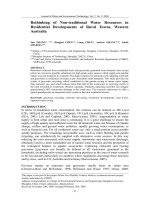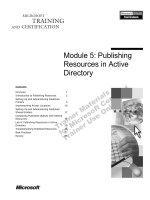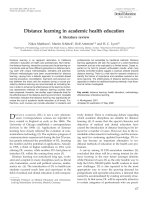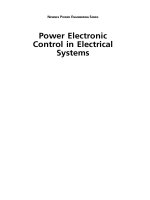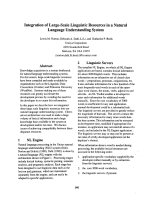Licensing electronic resources in academic libraries
Bạn đang xem bản rút gọn của tài liệu. Xem và tải ngay bản đầy đủ của tài liệu tại đây (9.24 MB, 202 trang )
LICENSING
ELECTRONIC
RESOURCES IN
ACADEMIC
LIBRARIES
This page intentionally left blank
LICENSING
ELECTRONIC
RESOURCES IN
ACADEMIC
LIBRARIES
A Practical Handbook
COREY S. HALAYCHIK
BLAKE REAGAN
Chandos Publishing is an imprint of Elsevier
50 Hampshire Street, 5th Floor, Cambridge, MA 02139, United States
The Boulevard, Langford Lane, Kidlington, OX5 1GB, United Kingdom
Copyright r 2018 Elsevier Ltd. All rights reserved.
No part of this publication may be reproduced or transmitted in any form or by any means, electronic or
mechanical, including photocopying, recording, or any information storage and retrieval system, without
permission in writing from the publisher. Details on how to seek permission, further information about the
Publisher’s permissions policies and our arrangements with organizations such as the Copyright Clearance
Center and the Copyright Licensing Agency, can be found at our website: www.elsevier.com/permissions.
This book and the individual contributions contained in it are protected under copyright by the Publisher
(other than as may be noted herein).
Notices
Knowledge and best practice in this field are constantly changing. As new research and experience broaden
our understanding, changes in research methods, professional practices, or medical treatment may become
necessary.
Practitioners and researchers must always rely on their own experience and knowledge in evaluating and
using any information, methods, compounds, or experiments described herein. In using such information or
methods they should be mindful of their own safety and the safety of others, including parties for whom they
have a professional responsibility.
To the fullest extent of the law, neither the Publisher nor the authors, contributors, or editors, assume any
liability for any injury and/or damage to persons or property as a matter of products liability, negligence or
otherwise, or from any use or operation of any methods, products, instructions, or ideas contained in the
material herein.
British Library Cataloguing-in-Publication Data
A catalogue record for this book is available from the British Library
Library of Congress Cataloging-in-Publication Data
A catalog record for this book is available from the Library of Congress
ISBN: 978-0-08-102107-1 (print)
ISBN: 978-0-08-102108-8 (online)
For information on all Chandos Publishing publications
visit our website at />
Publisher: Jonathan Simpson
Acquisition Editor: Glyn Jones
Editorial Project Manager: Katie Chan
Production Project Manager: Debasish Ghosh
Cover Designer: Christian J. Bilbow
Typeset by MPS Limited, Chennai, India
DEDICATION
Blake would like to dedicate this work to:
Dr. R. Kendra Kemmet: Thank you for providing me excellent medical
care, and for giving me hope, when I was facing the most difficult
circumstances of my life.
My parents, for their encouragement and support. Thank you for
teaching me many valuable skills.
And, to Mark Paganelli, for believing in me, giving me excellent
guidance, and giving me many opportunities to advance my career.
Corey would like to dedicate this work to:
Chris, for being the best assistant ever!
Houndini and the Bear for bringing me joy.
And, Nyarlathotep for showing me The Way.
This page intentionally left blank
CONTENTS
About the Authors
Foreword
Acknowledgments
1. Basics of Library Licenses
Introduction
2. Library Process Improvement Considerations
Introduction
Process Improvement Considerations
Lean & Six Sigma
Five “Whys”
The Three “M”s of Toyota Production System
Contract Routing
Writing and Understanding Contract Language
Click-Wrap/Browse-Wrap/or Other End-User Terms
Stakeholder Relationship Building
On Checklists
On Document Creation
On Macros
Contract Negotiation
Library Contracts
Consortia Purchases
Copyright
Course Packs/Electronic Reserves/Virtual Learning Environments
Geographical/Institution/Unified Campus
Informing Authorized Users of Limitations
Interlibrary Loan
Monitoring and Reporting Misuse
Patron Record Maintenance
Return of/Destruction of Materials
xi
xiii
xv
1
1
85
85
85
85
88
93
93
95
95
96
97
97
98
100
101
102
102
103
103
104
104
105
105
106
vii
viii
Contents
Single Username/Password of Email Format
Supplying Patron Records
Usage Statistics
Walk-In Users
Possible Ideas for a Contract Manual
3. Basics of Licensing Law
Introduction
Basics of Contract Law
Basic Overview of Intellectual Property Licenses
What Affects Your Library?
Indemnification/Hold Harmless
4. License Layout and Lifecycle
Introduction
General Layout
Lifecycle
5. Negotiating Licenses
Introduction
Section One: Negotiation Stages
Stage One: Investigate
Stage Two: Commit
Stage Three: Review
Stage Four: Give-and-Take
Stage Five: Finalize
Section Two: The Playing Field
Understanding the Field
Organizational Roles
Economic Health
Competition
Purchasing Power
Resources
Influence
Leveling the Playing Field
Organizational Roles
Economic Health
Competition
Purchasing Power
106
107
107
108
108
115
115
116
116
120
122
123
123
123
128
129
129
130
131
134
135
137
139
140
140
141
143
143
144
144
145
145
145
148
148
149
Contents
Resources
Influence
Section Three: Relationships
Building Relationships
Time
Clear and Consistent Approach
Maintaining Relationships
Section Four: Approaches
Influences
Individual Approach
Team Approach
Section Five: Tools
Matrix
Objectives Template
Concession Grid
Meeting Agenda
License Checklist
Master Agreement
Conclusion
References
Index
ix
150
150
151
151
152
153
157
160
160
163
166
169
169
170
172
173
175
176
177
179
181
This page intentionally left blank
ABOUT THE AUTHORS
Corey S. Halaychik is an award winning librarian who has held
leadership positions in the hospitality, map publishing, and library
industries. He has worked across many library departments, including
reference, access services, and electronic resource units in both public and
academic settings where his work and research have focused on improving
efficiency, teamwork, and leadership skill development. He previously
served as Chair of the Department of Library Services at Three Rivers
College in Poplar Bluff, Missouri, and his current role is Assistant
Professor and Head, Acquisitions and Continuing Resources for The
University of Tennessee Knoxville. Corey is also co-founder and
co-director of The Collective (thelibrarycollective.org), a professional
library gathering founded in 2015 and dedicated to reinventing the library
conference landscape. He holds an MLIS from Florida State University
and a MS in Leadership from Grand Canyon University. He is a Florida
native but currently resides in Tennessee with his faithful sidekick,
Jackson the Wonder Hound.
Blake Reagan earned a B.A. and a J.D. from The University of
Tennessee at Knoxville. He has an active Tennessee law license as of 2007
and has worked in higher education procurement since July 2008. He is
currently the director of procurement services for The University of
Tennessee. In 2015, Blake received the Young Procurement Professional
Award from the National Association of Education Procurement.
xi
This page intentionally left blank
FOREWORD
Contracts: They are, almost literally, everywhere. From your social
media accounts, to your laptop, to your cell phone, to your credit or
debit card, most of daily life is governed by contractual terms. As in
your personal life, much of your professional life is governed by contracts, too. This book is written for electronic resource professionals
working in libraries.
In this book, we recommend other books, training seminars, blogs,
and other training programs. These recommendations are all unpaid
endorsements, and represent the authors’ experience with these books,
seminars, programs, etc. While the authors hold strong opinions as to the
quality of their recommended sources, the authors are not responsible for
your use of these sources, and the authors’ statements do not guarantee
any particular results.
Lastly, here is an important disclaimer: nothing in this book is legal or
other professional advice. While the authors relate stories of changes or
practices that have benefitted their employers, the authors do not make
representations about the likelihood of these practices producing the same
or similar results for your organization.
xiii
This page intentionally left blank
ACKNOWLEDGMENTS
Blake Reagan specially thanks Kenneth A. Adams, author of A Manual of
Style for Contract Drafting, Fourth Edition, for granting permission to the
authors to utilize Mr. Adams’ model contract language. Citations appear
where appropriate. The authors highly recommend Mr. Adams’ website,
seminars, blog, and books. Mr. Adams’ seminar on drafting clearer
contracts is particularly beneficial for anyone seeking to have a better
understanding of contract language. Mr. Adams inspires Reagan to
improve his contract-drafting skills continuously.
Reagan also specially thanks The University of Tennessee for their
support throughout his career.
xv
This page intentionally left blank
CHAPTER 1
Basics of Library Licenses
INTRODUCTION
What is a License?
While the analogy is not an exact parallel,1 perhaps it is easiest to think of
a license like an apartment lease.2 In an apartment lease, the property
owner (“landlord” or “licensor”) gives the tenant (“lessee”) rights to use
the property. The landlord and lessee agree in a contract (“lease”) the
terms under which the lessee may occupy the landlord’s premises. When
it comes to intellectual property related to our purposes in this book,
under a license, the licensor (owner of the intellectual property3) grants
to the licensee a nonexclusive right to use the licensor’s property in certain ways, and prohibits certain uses. In exchange, the licensee will pay
the licensor for the rights to use licensor’s property.
In a license, the licensor retains ownership to their property.4 Often,
the licensor might be licensing content that is owned by third-parties. In
that case, the third-parties have licensed content to the licensor, and the
licensor has the right to sell your organization a license.
Licenses are contracts. Contracts are binding agreements (“a promise
that the law will enforce”5), which are agreed upon by two or more parties. The general functions of a contract are to:
1. Allocate risk from one party to another;
2. Set forth how the parties will behave during routine interactions;
3. Set forth the rights and obligations of each party; and
4. Describe the parties’ remedies if things go wrong.
It might be useful to think of contracts as “private law,” a set of laws
to which the parties voluntarily agree.
1
2
3
4
5
Leases give residential or commercial tenants certain exclusive rights to property. The
types of licenses we will discuss do not involve exclusive licenses.
Stim (2010, pp. 261À264).
The licensor might not always be the content owner, but for sake of simplicity, we
assume the licensor is the owner.
Stim (2010, pp. 261À264).
This is the definition that one coauthor remembers from his first-year, first-semester
Contracts I professor (George W. Kuney) giving to the class. It is a great definition.
Licensing Electronic Resources in Academic Libraries
DOI: />
© 2018 Elsevier Ltd.
All rights reserved.
1
2
Licensing Electronic Resources in Academic Libraries
Why Do Licenses Exist?
Licensors use licenses to help ensure they can protect their property, or
protect the rights of others who own the property if the licensor is sublicensing the property. Licensors use contracts to help create certainty and
reduce risk as it relates to the licensed property. Licensors also use licenses
to spell-out how licensees may use the licensed product.
Without a license, (excluding whatever rights one might have under
the provisions of U.S. copyright law, including Fair Use), no one could
use the owner’s product. Licenses allow an organization to use the product for the purposes, and at the price, stated in the license.
Why Do Licenses Matter?
Licenses matter because licenses are binding legal documents. Failure to
adhere to the terms of a license could result in loss of access, extra costs
(in the form of liquidated damages), audits, or lawsuits—or, all of these
negative outcomes. Moreover, failure to comply with a license’s terms
could result in public-relations issues or other reputational concerns for
your organization. Ultimately, licensors do not have to sell your organization a license to the licensor’s products. Of course, licensors must sell
their licenses in order to stay in business, but your organization does not
have a right to the licensor’s content—unless you have a license agreement with the licensor.
It would be difficult to overstate the importance of understanding
every word in your licenses.6 While perhaps a rare occurrence, licensors
could sue your organization. Moreover, it is possible that third-party content owners could sue your organization, if your organization breaches
the license agreement. A more likely scenario is that a license contains
language requiring your library to pay for the licensor to audit your
library should the licensor’s audit reveal your library breached the license.
Alternatively, the license could require your library to pay liquidated
damages (a phrase that means a certain, stated amount of money, agreedupon in the contract) to the licensor if your organization breaches the
license agreement. Also, it’s possible (though, probably unlikely) that a
6
To improve your contract skills, the coauthors highly recommend the works of Kenneth
A. Adams.
Basics of Library Licenses
3
licensor could sue library staff in their individual capacity, especially if the
library is a private-sector entity.7
In this chapter, we will discuss a basic overview of the library-license
acquisition process, and then discuss common terms that appear in library
licenses. We will close this chapter with a sample licensing agreement.
Processes
The processes involved in the acquisition of library licenses will vary—at
times, perhaps dramatically—depending on various factors. Some of those
factors are:
• whether the organization is public or private [public-sector entities
tend to be more prone to red-tape];
• the size of the organization [large organizations tend to be less efficient
than smaller ones];
• staff size and resources of the applicable offices in the license-review
process; and,
• the organization’s policies and procedures related to licenses.
The coauthors backgrounds are in the public-sector, specifically in a
public higher-education organization. Accordingly, the following content
discusses the general procurement processes involved in public-sector
license acquisition. Please note that each organization’s processes will
almost certainly vary from the generic process outlined below. More to
the point, unless specifically stated, please do not assume that our outline
of a generic process is our recommendation for you to adopt the process
as a best practice.
Of course, all organizations (public and private) are governed by applicable laws. Almost all organizations, whether public or private, maintain
official policies to govern internal conduct. All entities will have procedures in place to accomplish goals and stay within the organization’s policies. The distinction between a public and private organization is
noteworthy because a major difference between the private-sector and
the public-sector is as follows: private-sector entities may do anything,
unless laws prohibit the actions, whereas public-sector entities are only
7
Most, if not all, government-sector agencies have sovereign immunity, which might
shield staff from individual lawsuits, provided that the employee’s actions were within
the course and scope of their employment. Laws vary by state. Consult your legal counsel for authoritative information.
4
Licensing Electronic Resources in Academic Libraries
allowed to do what the law allows them to do. In some cases, the difference might be theoretical because many private-sector entities have redtape, just like government agencies.
Whether public or private, the odds are that your library will work
with some, or all, of the following offices to acquire a license:
1. Most common external processes:
a. Licensor’s salesperson;
b. Licensor’s executive-level decision-maker;
c. Licensor’s contract-management office.
2. Possible external processes:
a. Licensor’s in-house legal office;
b. Licensor’s external legal office (if no in-house legal office);
c. Licensor’s auditors;
d. State legislature committee;
e. Members of the general public (depending on your organizations
public-records policies);
f. State controller/audit.
3. Internal:
a. Procurement office8;
b. Contract office9;
c. Centralized business office at the campus-level;
d. Legal office10;
e. Accounts payable office;
f. Authorized official to sign the contract11;
g. Internal audit;
h. Other general administrative steps.12
When it comes to the internal review processes: some entities might
require a library to work with all of these divisions of the organization,
8
Also commonly referred to as “purchasing,” and less commonly referred to as “supply
chain” or “supply chain management.” In the private-sector, the office is often called a
“supply chain” office. In the public-sector, the office is usually called “purchasing” or
“procurement.”
9
The private-sector often does not have a separate contract-review office. In the publicsector, a growing trend in the United States is to merge the procurement and contract
functions under one office.
10
Commonly known as the “Office of General Counsel,” or the “Legal Affairs” office.
11
Usually, this is an officer of your organization (i.e., president, controller, treasurer, chief
financial officer, etc.).
12
This might include review by the Board of Trustees, a central office at the state’s legislative or procurement office, or other administrative review.
Basics of Library Licenses
5
whereas other entities might have a more-streamlined approach. In other
words, your library might have to work with a procurement office, a contract office, a centralized business office, etc.
Of course, the license must be negotiated with the licensor. When we
use the term “negotiated,” this includes: (1) negotiating the businessdecisions (i.e., pricing, payment terms, time length, etc.); and, (2) negotiating the terms (i.e., interlibrary loan, governing law, etc.). Note that, for
purposes of this book, the coauthors will treat procurement and contracts
as the same process. Generally, the coauthors will refer to all internal
review steps as the review process.
If you “take-away” only a few key points from this book, one key
point is that relationship-building with all the people at each stage of the
review process is critical to success. Another key point is the power, and
necessity, of good processes. The opinion of the coauthors is that many
organizations focus too much on adding (sometimes costly) software, adding other technology, and adding staff, when simple process improvements and promoting better relationships with internal stakeholders could
solve the problem and improve the entities’ functions.
Understanding Stakeholder Perspectives
When it comes to creating a more effective license-review process, there
are many areas that we could discuss:
• Contract review and negotiation skills;
• Contract-management techniques;
• Price negotiation skills;
• Staffing levels;
• Training staff;
• Pricing terms;
• Software and other task-management tools;
• Process-improvement techniques (such as Lean or Six Sigma); and,
• Relationship-building.
Of the above, in our opinion, relationship-building is one of the most
important. Consider this: assume you are creating a business, and you’ve
sent your lawyer paperwork for review. It is easy for us to assume that
our lawyer’s top priority is our paperwork and that she does not have any
other pressing concerns. Similarly, it is too easy for any of us to consider
the licensing process from our limited perspective. If my perspective is
that of a librarian, it is easy to assume that the procurement office does
6
Licensing Electronic Resources in Academic Libraries
not have much to do. In this hypothetical example, when another department’s turn-around time does not meet expectations, you might assume
that the procurement office is suboptimally performing. As is often the
case in large entities, it is too easy to shift blame to a different unit and
state that “they take forever” or “they just do not get it.”
Understanding stakeholder perspective and duties is important, and
will help further your relationship-building with key stakeholder departments. It might be helpful to ask each stakeholder to meet with you regularly. Perhaps show the stakeholder your office’s average monthly
workload, and ask to see the stakeholder’s. Be sure to approach these
meetings with an open mind. It is possible that a procurement office that
seems slow to outsiders is performing as well as it can under the given circumstances. Perhaps the office is short-staffed and the director is working
over 100 hours a week to help keep up with the workload. Perhaps the
organization’s official policies, or even state laws, add metaphorical hurdles to the process, which create sub-optimal process times. Alternatively,
the procurement office might not be aware of your library’s complaints. It
is impossible for stakeholders to be aware of your concerns unless you
communicate your concerns to them.
It might be tempting to use "us vs. them" thinking when looking at
stakeholders. To help maintain good professional relationships, it’s best to
operate on the belief that no stakeholder is an enemy. When it comes to
internal stakeholders, all such stakeholders are on the same team.
Focusing on building relationships with all internal stakeholders is a critical task, and building relationships with stakeholders is a best practice the
coauthors recommend for your library.
In the public-sector, the following stakeholders’ perspectives might
look something like the following:
• Legal13: primarily focused on risk identification (often, risk elimination), and compliance. The legal office’s perspective is often not
focused enough on the organization’s business performance. As an
attorney, and speaking from experience, one of the coauthors
13
Developing a relationship with your legal office is particularly important. As an attorney, one coauthor can attest to the fact that very few attorneys have an understanding
of business needs. At least, most attorneys tend to focus more on identifying and eliminating risks, instead of focusing on “getting it [the deal] done.” Legal plays an important role in the licensing process, and legal will be the office that has to handle any
lawsuits that arise from your licenses. Note, however, that attorneys will often place
risk avoidance over everything else.
Basics of Library Licenses
•
•
•
•
•
7
feels confident stating the following: many, but certainly not all,
attorneys lose sight of the fact that the business leaders of an
organization run the organization, and, that legal advice is just
that—advice.
Procurement14: primarily focused on compliance with (1) state procurement laws, and (2) internal policies of the organization. Highperforming procurement operations are customer-focused, and view
all internal departments (e.g., your library) as a customer.
Central business office: primarily focused on compliance with internal
policies of the organization, state laws, budget management, and overall organizational concerns.
Accounts payable: primarily focused on the payment process, avoiding
over-payment, avoiding fraud, and ensuring that all payments comply
with the contract or purchase order.
Internal audit: primarily focused on ensuring that the organization
adheres to law and the organization’s official policies.
Library: primarily focused on meeting the needs of its users and the
community. Only your library will be able to identify all of the
business/operational issues that arise in a contract. You cannot rely on
the other offices in the review process to determine whether your business needs will be met in a contract. For example, the legal office, most
likely, will not catch issues such as walk-in users, course reserves, etc.
Common Steps and Time-Line
A common library acquisition process might look as follows:15
1. Library identifies need to buy, or renew, a license.
2. Library contacts the licensor.
3. The licensor’s sales staff submit draft pricing and contract documents
to the library.
4. The library obtains library-business-office budget approval.
5. The library’s business or license-management staff routes the contract
through the approval process.
6. The organization’s procurement office negotiates legal terms with the
licensor.
14
15
With the adoption of lean six sigma principles, procurement offices can be a force for
positive change and value-creation through business-process improvements.
This is a generic set of steps intended to mirror the general current practice within
public-sector organizations. This is not a set of best-practices.
8
Licensing Electronic Resources in Academic Libraries
The organization and licensor mutually agree on terms.
Both parties sign a contract.
Supplier activates the library’s license.
Library staff receive an invoice, and pay for the license.
Library staff members ensure that the library complies with the terms
of the license.
12. The license expires or is renewed.
The cycle time (i.e., amount of time it takes from the beginning of a
process to the end) can vary dramatically based on various factors. It
might be surprising for libraries to hear this, but, in our experience, the
longest delays usually result on the licensor’s side of things. Suppliers have
their own review processes, legal office, signature authority rules, etc.,
which the licensor’s staff must follow.
In our experience, common reasons for delays in cycle time are as
follows:
• Library keeps the contract for several days before submitting through
the approval process.
• Organization uses paper documents and manual routing (i.e.,
campus mail)
• Organization does not have contract-management software.
• Organization’s procurement office is under-staffed.
• Organization uses suboptimal queue management techniques.
• Supplier fails to account for public-sector entities’ needs when it
comes to terms, and fails to create templates for public-sector agencies
which contain terms that would be readily acceptable to most publicsector agencies.
• Supplier is slow to respond when your organization asks the licensor
to revise its license.
7.
8.
9.
10.
11.
License Origination
When considering the library license, there are either “original” (new)
licenses or amendments. When it comes to amendments, libraries usually process amendments to renew a license or to add products, or
both. Typically, libraries will be responsible for ensuring that they monitor the end-dates of their licenses, and submit renewal documentation
in plenty of time. If your organization is manually tracking renewal
dates, the coauthors recommend buying an enterprise license for
